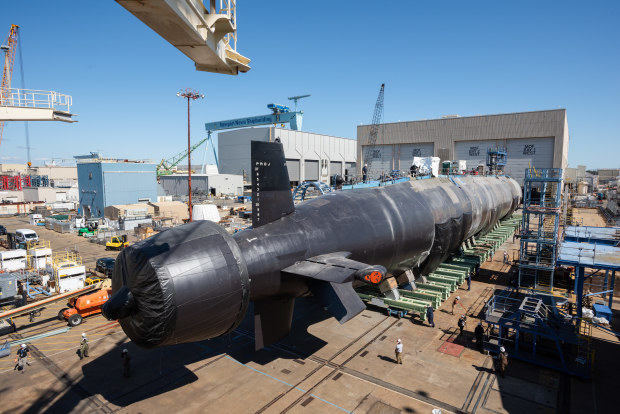One of the two US submarine builders says it is looking to Australian companies to contribute to the supply chain and ease manufacturing bottlenecks as production ramps up to divert boats to the Australian Navy under AUKUS as well as grow the US fleet.
Top managers from Huntington Ingalls Industries are visiting Australia to inspect shipyard facilities in Adelaide and Perth and to meet Defence officials as the US defence giant establishes a presence in Australia to help develop the regime for operating and maintaining nuclear-powered submarines.

“We very much view this as a generational partnership and one that we’re leaning in to, and one that we believe will help generate capability and capacity in Australia,” HII’s executive vice president for strategy and development Eric Chewningsaid at a media briefing.
Under the AUKUS pact, US and UK submarines will step up their visits to Australia from this year and they will be based here from 2027. In the early 2030s, Australia will receive between three and five US Virginia-class submarines. The first locally made AUKUS-class nuclear-powered submarine will be delivered to the navy in the early 2040s.
HII builds Virginia-class submarines for the US Navy in Virginia. Electric Boat produces them in Connecticut. The two companies are also collaborating on the nascent Columbia class.
Despite pressure to grow the size of the fleet, submarine production has slumped in the US. The two shipyards are collectively completing 1.4 Virginia-class submarines a year because of supply chain disruption and production delays due to a shortage of workers.
The US hopes production will average two boats a year by 2028 but it will need to average about 2.4 boats from 2030 to replace the two secondhand Virginia-class submarines being sold to Australia and up to three more straight off the production line.
Production booster
To help boost production, Australia has committed $3 billion over four years for the industrial base in the US and Britain.
Mr Chewning, a former senior Pentagon official, said the AUKUS benefits would flow both ways. The involvement by Australian suppliers would add to the US capacity and ease bottlenecks and it would also help with the transfer of cutting-edge technology and skills back to Australia.
“We’re sort of full back home,” he said.
“In order for us to meet that requirement, we need to think about how we expand industrial base capacity. So it’s in that context we’re very much viewing Australia as an opportunity for us to expand industrial base capacity for the system.
“And then in so doing, help build the sovereign capability you’ll need for SSN AUKUS [the first locally made submarine] out in the future along the optimal pathway.
Australian industry needs to be part of the solution.
— Eric Chewning, Huntington Ingalls Industries
“We effectively need to keep on the ramp we’re on and not let the pedal off the metal to help recover the time. Australian industry needs to be part of the solution.”
The builder of the submarines in Australia is not yet known. British giant BAE Systems is in the box seat, as it builds the British submarine fleet and the SSN AUKUS will be used by both the British and Australian navies. It already has a strong presence in Australia.
Mr Chewning said HII saw two ways it would be able to fit into the Australian submarine ecosystem. The first was supporting the development of a workforce and industry, helping them to get qualified as part of the nuclear supply chain.
Secondly, HII could help manage the nuclear lifecycle, which includes sustaining Virginia-class submarines that are deployed to Australia and the eventual disposal of nuclear waste.
Mr Chewning said Australian workers would be given opportunities to learn specialist skills in the US, such as the higher standards for welding on a nuclear-powered submarine compared to conventionally powered ones. He did not say the number of workers that would go overseas.
“They’ll be working in our shipyards. That helps us address workforce challenges we have and they’ll be able to come back home and help build the capability.”
Source : FINANCIALREVIEW











